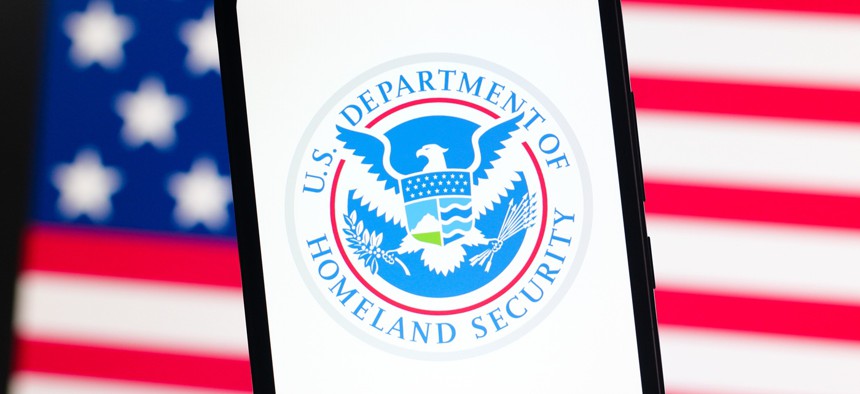
The Homeland Security Department’s Office of Intelligence and Analysis reportedly now aims to reduce its size to around 500 people via a second deferred resignation program offer. Thomas Fuller / SOPA Images / LightRocket / Getty Images
Homeland Security intelligence office sent deferred resignation offers to shed staff in recent months
The DHS Office of Intelligence and Analysis is working to incrementally reduce the size of its workforce, following plans for mass cuts that faced severe pushback from stakeholders over the summer.
The Department of Homeland Security’s Office of Intelligence and Analysis since the summer has sent its employees offers to leave the government early while taking pay for a set amount of time, marking a renewed push to shed its headcount after it faced scrutiny for related reduction plans outlined earlier this year.
The offers to apply to the deferred resignation program, or DRP, were modeled on the Office of Personnel Management’s “fork in the road” effort and sent twice to I&A staffers since July, according to a copy of one of those offer emails issued in September and a person familiar with the matter. The person spoke on the condition of anonymity because they were not authorized to publicly discuss the details of the plans. The email also included options to participate in a Voluntary Separation Incentive Program and Voluntary Early Retirement Authority.
The offers were extended after Nextgov/FCW first reported in July that the intelligence agency was seeking to jettison most of its employees. Those plans, which would have only kept some 275 people, drew major pushback from law enforcement groups and Jewish organizations that have long relied on the DHS spy agency to disseminate timely intelligence about threats that target state, local, tribal and territorial communities. One organization privately warned Congress that the proposed cuts would create “dangerous intelligence gaps.”
The cuts were put on hold just days later, Nextgov/FCW first reported. But since then, I&A has reignited efforts to more gradually shed its workforce, according to the person. The office now aims to reduce its size to around 500 people via the second DRP offer, said the person, who added that the office’s total full-time staff has been brought down to some 700 people since the summer via early retirement and DRP offerings.
The 500-person figure would preserve more people than the initial plans to cap the workforce at 275, though that still halves staffing from the around 1,000 that were in place earlier this year.
I&A employees had until Sept. 14 to submit their information for the second deferred resignation, according to the email. Approved staff would remain on administrative leave for 12 weeks, giving them pay until early December, it adds. It is not clear how the ongoing lapse in federal funding impacts these agreements.
The programs “provide an opportunity to make decisions as part of the restructuring effort underway in DHS headquarters,” the email says. It was not immediately clear how many people inside the agency elected to take the DRP.
For years, both intelligence insiders and outside experts have maintained that I&A needs major restructuring to operate more effectively and protect against domestic overreach, the latter of which it has been widely accused of in the past. But the deep cuts put on the table over the summer put the office at odds with the communities it serves.
The lesser-known intelligence office is one of 18 in the U.S. intelligence community, and one of two housed under DHS, the other being Coast Guard Intelligence. I&A was assembled shortly after the September 11 terrorist attacks to help disseminate domestic threat information.
U.S. spy agencies, including major offices like the NSA and CIA, have been marked for workforce reductions in President Donald Trump’s second term. Various intelligence offices are also affected amid the ongoing government shutdown. I&A has 544 employees who are still working during the lapse in federal funding, according to a DHS planning document.
“I&A is fully prepared to respond to any and all threats and will continue to provide full resources and protection to all religious community groups,” a DHS spokesperson said. “Under President Trump, we are maximizing efficiency through reductions in the federal workforce to best use taxpayer dollars and rid DHS of bureaucracy that undermines safety and security.”
Editor's note: This article has been updated to include comment from DHS.







